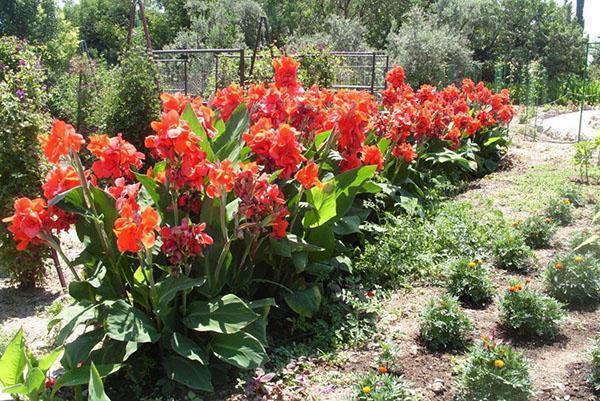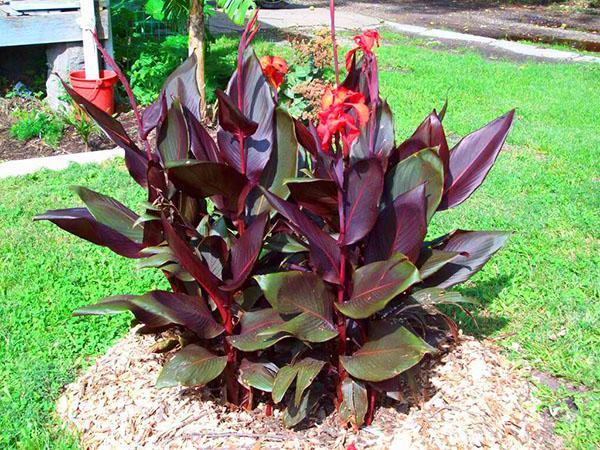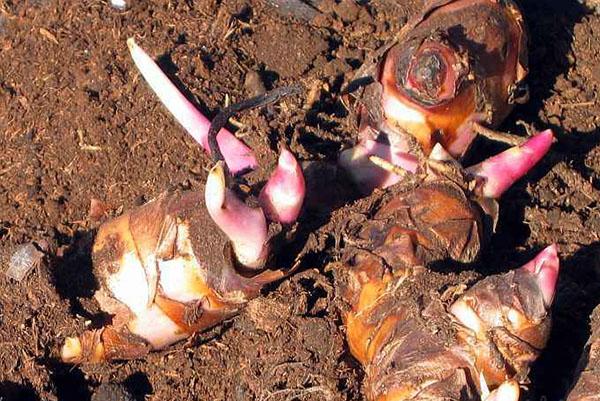How to create a tropical-style flower garden with cannes planting
 It is always pleasant to look at the well-groomed garden plot, where beautiful flowers and shrubs are collected in the compositions of the flower beds. Each plant requires certain attention, for example, cannes - planting and care in the open field have certain nuances, on which the decorative effect of the bush depends.
It is always pleasant to look at the well-groomed garden plot, where beautiful flowers and shrubs are collected in the compositions of the flower beds. Each plant requires certain attention, for example, cannes - planting and care in the open field have certain nuances, on which the decorative effect of the bush depends.
Preparation for planting in open ground

- traces of insects;
- rot;
- internal voids.
Planting cannes in open ground in spring is carried out with caution and in several stages. In order for the plant to bloom violently in June, it is necessary to germinate the rhizomes in early March. You will need dry sawdust and a shallow container for this procedure. The germination algorithm is simple:
- Pour sawdust into the pot.
- Place it in a room with an average temperature of 24 - 26 degrees.
- Moisten the planting material with water at room temperature.
- Place the canna tubers on top, lightly sprinkling them with wood material.
- As the sawdust dries, moisten it with warm water.
- Transplant after the first shoots appear in spacious pots, after removing the dry and lifeless roots.
After transplantation, it is necessary to maintain the conditions necessary for the normal life of the sprout. The temperature where the canna is grown should not be lower than 17 ° C, because this flower is thermophilic and came to us from the warm southern continents. But it is also not worth increasing the temperature regime - before planting the cannes in open ground, it must be hardened.
The main condition for the formation of a strong bush is sufficient lighting.
If there is little light, the sprouts will stretch, and the leaves will lose their rich green color. As an additional light source, you can use a tabletop lamp or keep the light in the room longer in the evening.
Relocation of a plant to open ground
 The main question remains when to plant cannes in open ground? Due to the fact that the canna does not tolerate cold weather, it is necessary to plant it in open ground after the threat of night or morning frosts has passed.
The main question remains when to plant cannes in open ground? Due to the fact that the canna does not tolerate cold weather, it is necessary to plant it in open ground after the threat of night or morning frosts has passed.
In the southern part of Russia, the planting period begins in late May and lasts until mid-June.
Late planting threatens that the flower will take a long time to gain inflorescences or may not bloom at all. If you plant a tuber without prior germination, then flowering will begin no earlier than mid-July.
 Planting and caring for cana outdoors in the Urals and in other cool regions begins in early June, provided that the plant will take shelter at night until mid-summer. There are no other nuances in caring for a plant in areas with different climatic conditions.
Planting and caring for cana outdoors in the Urals and in other cool regions begins in early June, provided that the plant will take shelter at night until mid-summer. There are no other nuances in caring for a plant in areas with different climatic conditions.
When choosing a permanent place of residence for cannes, it is necessary to take into account the fact that the flower is thermophilic and will delight you with abundant flowering if you create comfortable conditions for its growth.
The area where the canna is planted should be:
- as sunny as possible;
- protected from drafts and strong winds;
- cleared of weeds and dry roots;
- well fertilized.
It is necessary to take into account the fact that the plant reaches a height of 1.5 - 1.8 m, so the space should be as free as possible, because the seedlings are located at a distance of half a meter from each other.
After the location has been chosen, you need to prepare the holes for planting the plant in open ground. The sizes are taken individually and depend on the volume of the rhizome and the height of the shoots. The root should be located at a depth of 7-10 cm, but you need to add more space for humus, which will improve the growth of the canna.
Landing is done like this:
- Pour 1.5 - 2 liters of warm water into the dug hole.
- Add humus or dry manure.
- Sprinkle with 2 cm of earth.
- Drizzle with warm water.
- Pour in or pour in the recommended dose complex fertilizer.
- Place a seedling in the middle of the hole and sprinkle with earth.
- Water abundantly.
In order to prevent root rotting from an excess of moisture, you need to mulch the soil around the plant when planting it.
When the canna is planted outdoors, it must be properly cared for.
How to properly care for a canna
 After the transplant, the canna experiences discomfort. In order for the adaptation to take place faster and the seedling to take root, you need to water the plant often during the first 3 weeks. Further watering is reduced to 2 - 3 times a week. The frequency depends on the climatic conditions of growth, if the summer is rather dry, monitor the constant moisture of the soil, because the water intensively evaporates from the large leaves of the flower.
After the transplant, the canna experiences discomfort. In order for the adaptation to take place faster and the seedling to take root, you need to water the plant often during the first 3 weeks. Further watering is reduced to 2 - 3 times a week. The frequency depends on the climatic conditions of growth, if the summer is rather dry, monitor the constant moisture of the soil, because the water intensively evaporates from the large leaves of the flower.
 Along with the importance of watering, make sure that the water does not stagnate near the roots.
Along with the importance of watering, make sure that the water does not stagnate near the roots.
Intensive loosening of the soil around the canna is the prevention of rot and fungal diseases.
The flower is just a godsend for novice florists, because it is resistant to many diseases and does not require special conditions for planting and care in the open field. But the main decorative elements of the plant, leaves and inflorescences, need close attention and also need to be looked after:
- Spray the leaves from a hose with a special nozzle or a watering can. But by no means at lunchtime, because the leaves can burn!
- Wipe the leaves with a damp sponge once a week.
- Trim off yellow or dried leaves and flowers.

Mineral fertilizers are introduced not only during planting, but also throughout the growth of cannes. The frequency of feeding can be 3 to 4 weeks. First, nitrogen or potash fertilizers are applied, which enhance the growth and survival of the flower, and then you can give preference to combined dressings, where all the beneficial substances are contained in equal proportions.
If your plant has been affected by any disease or is being damaged by insects such as ants, aphids, or spider mites, treat the flower with insectofungicides.
Planting and leaving cannes in the open ground in the fall is not carried out, because when frost occurs, the flower will freeze. In any region, the tubers are dug up and sent to winter in a warmer place, such as a basement.
If you do not want to part with your pet for the winter, transplant it into a spacious pot or leave a couple of rhizomes in the spring to plant them at home during the cold season.